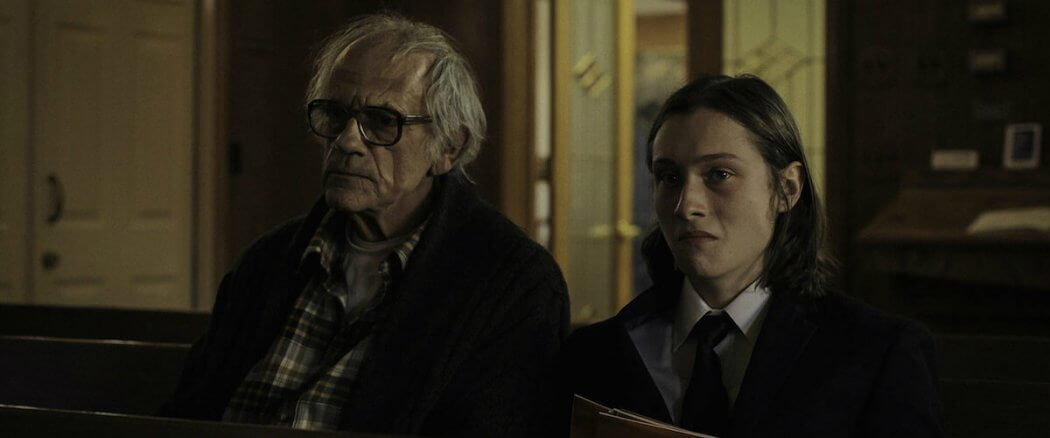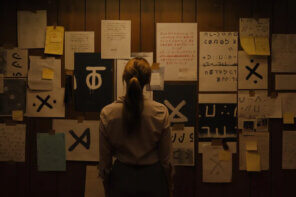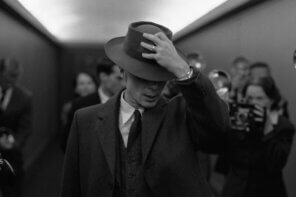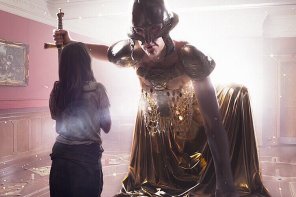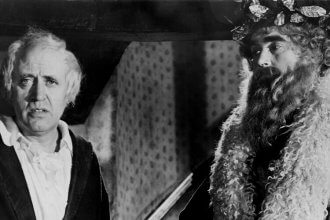The core protagonist here John Wayne Cleaver was definitely born with a serial killer’s name, and is brilliantly played by young Max Records (who also filled the shoes of the growing adolescent in Spike Jonze’s 2009 adaptation of Where the Wild Things Are). As seen in the film, being born with certain tendencies doesn’t chain us to them, however deep the urges may rattle inside the cage of one’s soul.
In short, I Am Not a Serial Killer is a deceptively simple, albeit remarkable, indie movie based on the novel of the same name about a 16-year-old kid with murderous tendencies trying to overcome himself and stop a true killer. Full of legitimately in-depth conversations about true morality, there’s a message here movie-goers of faith don’t often witness in the modern cinema.
Pay attention to the nuance of detailed scenes like John Wayne Cleaver in the school lunchroom, where he doesn’t bite into chicken off the drumstick, but rather uses a knife to carefully slice the meat off the bone prior to biting in. You can tell a lot about a character through such a seemingly insignificant scene.
A Superhero for the Horror Genre
Dancing the line between a superhero and one of the creepy slashers in You’re Next, teenage Cleaver eventually dons a panda-faced ski-mask, which he then uses to hide his true identity. The choice of a panda may seem an odd one until you consider that pandas are an innocent endangered species. Who is more endangered than a moral 16-year-old in a Hollywood movie?
Not that this directly influences my positive review of a film, but I Am Not a Serial Killer contains minimal profanity, along with zero sex, alcohol, or drug use (yes, pinch me, it’s a film about teenagers and the focus remains on moral issues beyond sex). As a side note, another recent film, The Autopsy of Jane Doe, featured equally likable characters who were also a son-parent duo running a small-town morgue, although there was definitely profanity and talk of “getting laid.” To be fair, Dean Koontz’ Odd Thomas character wouldn’t be terribly far off from what is displayed here, despite that series having significantly more humor.
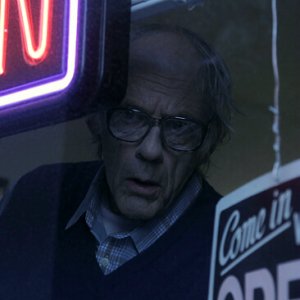 Christopher Lloyd’s role as Mr. Crowley (yes, Christopher Lloyd of Back to the Future fame) turns out to hands-down be an Oscar-worthy turn as one of the most sympathetic lead villains this author has ever seen. Played by a childhood hero of many Christians raised to do nothing but love the Back to the Future franchise, Lloyd’s casting no doubt allows for an added level of empathy right off the bat. Then again, to the director’s credit, it’s just as easy here to empathize with young John Wayne Cleaver, despite him being a relatively unknown actor. Coincidentally parallel to The Autopsy of Jane Doe, John Wayne Cleaver and his mother also work as morticians in this small Minnesota town, along with his aunt; Cleaver’s father has long since taken off and his sister rebelliously comes and goes.
Christopher Lloyd’s role as Mr. Crowley (yes, Christopher Lloyd of Back to the Future fame) turns out to hands-down be an Oscar-worthy turn as one of the most sympathetic lead villains this author has ever seen. Played by a childhood hero of many Christians raised to do nothing but love the Back to the Future franchise, Lloyd’s casting no doubt allows for an added level of empathy right off the bat. Then again, to the director’s credit, it’s just as easy here to empathize with young John Wayne Cleaver, despite him being a relatively unknown actor. Coincidentally parallel to The Autopsy of Jane Doe, John Wayne Cleaver and his mother also work as morticians in this small Minnesota town, along with his aunt; Cleaver’s father has long since taken off and his sister rebelliously comes and goes.
While John Wayne Cleaver is at heart a sociopathic loner, he spends his days helping the aging Mr. Crowley (also his across-the-street neighbor) by shoveling the walk for him and his wife, even going so far as to aid the old man in his weaker moments with urinating, undressing, and bathing. Even after discovering Mr. Crowley’s relentlessly morbid ways, Cleaver continues to assist him with kindness, unsure if Mr. Crowley is even human.
Doing the Right Thing Should Always Be Easier
The stark images of John Wayne Cleaver lying awake in his room late into the hours of the night provide further shots of subtle realism that’s all too rare. Anyone watching has been there; high school is definitely not all parties and proms. While displaying admirable courage to discover what Mr. Crowley is up to, Cleaver goes so far as to sell his struggling family’s Christmas gift to him (a knockoff iPod) just to afford the spy equipment for tracking the killer’s movement.
In John Wayne Cleaver’s attempt to protect the town from a recent series of disemboweling murders, a number of innocent people do in fact die. In Cleaver’s case, he tries to “abide by the law of the land” and alert police but the officers who arrive to the scene end up dead like the original victim. Taking into account fellow ethical conundrums faced by superheroes, this also happens to be a tragic side effect shared by countless missionaries who are kept awake at night. Again and again, horrible realities take place despite our sincerest efforts. The infinite question always persists that more could have been done to save those who departed from this world — which is, again, another theme drastically explored in the superhero genre.
In an eventual climax resembling Spiderman’s biggest unintentional reveals, the motif of teenage-superhero-with-a hidden-identity is intensified when only one other person discovers what he’s done to save their town. Credit seems a distant notion for young Cleaver, potentially reminding some of Proverbs 27:2, “Let another man praise thee, and not thine own mouth; a stranger, and not thine own lips.”
The Power of a Reluctant Hero
Delightfully honest and philosophical conversations between John Wayne Cleaver and his therapist, Dr. Neblin (just for fun, soccer fans might notice he looks remarkably like Liverpool manager Jürgen Klopp) ultimately result in Cleaver’s newfound strength to overcome violent desires. As he yells at his mother two-thirds way into the film with a knife in hand, whether it’s his true inner spirit talking or just the despair, “I don’t give a s*** that Max’s dad is dead, I don’t give a s*** that you could be next!” it’s entirely possibly young Cleaver truly doesn’t care. Yet he forces himself to honor the moral foundation he has, thanks mostly to Dr. Neblin’s words of wisdom that Cleaver actually finds kind of annoying.
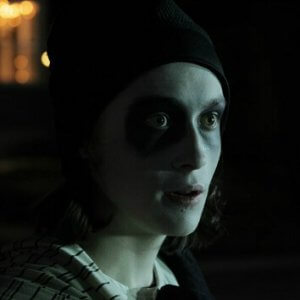 Consider that reluctant heroes are who God most often chooses to work through. Like fellow Cinema Faith reviewer Brian Cooper pointed out recently, sometimes it’s easier for God to utilize people on the brink of salvation, as opposed to those who have been saved all along. The former is arguably more in tune with the idea of grace.
Consider that reluctant heroes are who God most often chooses to work through. Like fellow Cinema Faith reviewer Brian Cooper pointed out recently, sometimes it’s easier for God to utilize people on the brink of salvation, as opposed to those who have been saved all along. The former is arguably more in tune with the idea of grace.
According to Wikipedia, this movie was shot on 16mm film for $1.45 million (chump change in today’s filmmaking process). That said, not even mediocre special effects can dissuade the villain’s final reveal. Remember that old Tales from the Dark Side: The Movie vignette with James Remar? Every demon masquerading as a human will display his true form eventually. The hidden tentacle-like features of ancient demonic creatures always prove triumphant in the works of H.P. Lovecraft (a vocal atheist). Watching this movie, excitement pumped through my veins, as in, “FINALLY! Why can’t a moral author like this explore the same mythological representation of evil?”
Man vs. Demon
Cleaver is not dealing with a man, he is dealing with a demon who must keep killing to go on living (killing to live is another motif here worthy of a separate conversation). Further questions quickly arise. In what shape or form is one’s true inner being? Is every killer in some sense a demon? Aren’t demons fallen angels just like evil men are a fallen version of good men?
When it comes to the climactic reveal of the villain, that scene in particular is not about John Wayne Cleaver protecting his mother, it’s about him wanting to protect his mother. It’s also about a mother finally trusting her son. The release of Mr. Crowley’s inner demon isn’t just an allegory for Mr. Crowley himself, it’s a representation of Cleaver’s inner struggle as well, and this is what they’re defeating.
In Context of Our Times
So many visual stories of our time have embraced a premise not at all unlike I Am Not a Serial Killer. The somewhat similar Dexter probably comes to mind. Apologies if you’re a fan of that TV show; it was admittedly a thunderous steam engine of a premise which slowly derailed into the mess of a writers’ room that couldn’t help but phone it in.
Likewise, our Hannibal generation has willfully delved into the minds of serial killers. 2015’s The Boy starring David Morse was a haunting portrait of a young serial killer in the making, although where it fell short was in chronicling the origin of evil as though it were the only inevitable result, not something to triumph in overcoming. The Disney films of our childhood always preached there is some good in everyone, yet never tackled the much more honest reality there is some evil inherent within the nature of men, women, and children alike.
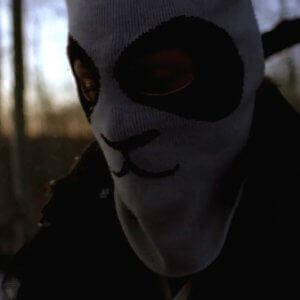 In viewing this movie, I’ve committed a critical sin of not having read the book. That will soon change. The author Dan Wells has certainly developed a level of intrigue within me to know more about what inspires his writing.
In viewing this movie, I’ve committed a critical sin of not having read the book. That will soon change. The author Dan Wells has certainly developed a level of intrigue within me to know more about what inspires his writing.
The closing scene is one of epilogue glory. Rather than succumb to the despair when preparing the body of a dearly departed family friend, Cleaver cracks a joke about the deceased. His family soon relents it’s what this particular dead person probably would have found funny. At the end of the day, could anything be more profoundly therapeutic for the human condition than turning something as grim as death into a moment of genuinely shared humor?
Of course not. But as Norman Greenbaum sings in the film’s rousing coda — the 1969 tune Spirit in the Sky of recent Guardians of the Galaxy soundtrack fame — while they suck the blood out of their dearest friend in preparation of his body for burial, “I got a friend in Jesus…”
That we do, my friends. That we do.

